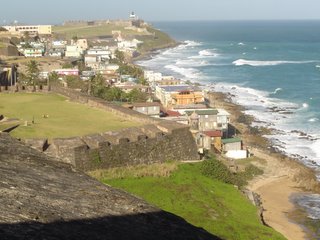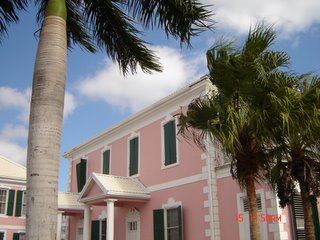The rich port and walled city

Viejo San Juan is known as “la cuidad amurallada,” or the walled city. The greatest Spanish military thinkers of the time believed that the walls would save the Spanish Crown and ultimately the New World Empire. Ten cities across the Caribbean Sea were deemed critical to the protection and expansion of the Spanish Empire, including Veracruz, Panama, and San Juan. This rich port city was surrounded by walls, with the largest two forts in all of the Americas, namely El Morro and El Castillo de San Cristobal. In the 17th century, they falsely believed that walls would keep out the foreigners by protecting its citizens from outside threats. It’s not too dissimilar from our country’s policies today. As the so-called Freedom Fighters battle Mexican immigrants from the southern border and Americans criticize our involvement and aid across the globe, we have much to learn from history. Indeed, after the fall of its Empire in the 1800s, Spain withdrew from the world into one of the most isolationist countries in all of Europe. What will be the fate of the U.S.?
This is Semester at Sea’s first call of port in Puerto Rico, San Juan, but la patria or land has an ancient history with its claim as the second oldest city in the Americas. In addition to the oldest Church in North and South Americas and the cobblestones brought directly from Spanish galleons, the Spanish influence is widespread and noticeable. As we left the cool Nassau breezes of January and the old British buildings, we entered waters that are warmer than the air, and traded English for Espanol. Despite rough seas and turbulent waters, even the Dramamine and seasickness could not contain the excitement in the air. Walking down decks 5 and 6, we see students and faculty/staff planning their adventures and practicing their Spanish. After two rolling and bobbing days at sea, there was not enough time for us to develop the “sea legs” that our crew describe, possibly on the trip to Brazil.
Due to the incessant day stops by Cruise ships in San Juan, we are porting 10 minutes outside of the main harbor. We only recently left U.S. Customs two weeks ago, but we are entering the Commonwealth of Puerto Rico, a U.S. protectorate since 1898 when the U.S. forces were welcomed in the southeast part of the island, and we must present our passports face-to-face with American port agents. Fruits, vegetables, and even water cannot travel between the ship and land. Dogs were brought on board to search the ship for drugs and our international friends were subject to intense scrutiny in direct interviews with Customs.
More walls.
The paradox of U.S. association in the Island of Enchantment confuses even the most well-traveled and well-informed international enthusiasts. Immediately preceding the Spanish-American War of 1898, the eroding Spanish Empire granted the Boricuas sweeping civil rights within the context of Spanish protection. The debate between independence and global power association has long been debated by the Puertorriquenos, but this development pleased both sides. As soon as the Americans moved in, the new agreement was tossed aside and a military government installed. They renamed the island to Portorico, one English word that was easier to pronounce until being changed back to Puerto Rico in the 1930s. A century later, 4 million people and even more cars populate the small island. Los tapones (traffic jams) and pirigueros (snow cones sales people) are common sites for cruise ship tourists, and Puerto Ricans now enjoy U.S. citizenship despite no voting rights in the U.S. government. Their two representatives attend Congress proceedings but cannot voice their constituents’ concerns or vote on any legislation. It is a double-edged sword. Since the 1940s, tourism and projects such as Operation Bootstrap and Governor Luis Munoz Marin, the first governor, have greatly improved the overcrowded island community (over 1,110 people per square mile). Even slums like La Perla (The Pearl, anything but a rare jewel) in Old San Juan now have Upward Bound and newly painted colorful building facades. The debate between statehood, independence and something in between continues, but the relationship with the States comes with advantages and challenges for the local puertoriquenos. Half prefer statehood, the other half the status quo. Independents are so marginal that they are almost not represented in the local government.
My time is Puerto Rico is short, only three days. La Bomba and plena musica pound in the streets. Few young Puerto Ricans know the old dances, but the mix of African, Caribbean and Spanish sounds and influences affect the great music, salsa and meringue. While eating mofongo and amarillos, I chat with teachers, dancers, and musicians. Over café con leche at a local shop, an older woman and I read the paper and discuss politics. There is even an article in the El Sol about Semester at Sea’s stop here in town and the two Puerto Rican students studying with us. I spend one day for kayaking Seven Seas near Fajardo, another for exploring and walking Old San Juan, and one more day is reserved for El Yunque, the only rainforest in all of the United States, and Luquillo, one of the most famous beaches in the Caribbean. I walked through many old Spanish plazas, like “la Barandilla” and “la plaza de la palomas” or pigeon square, and you see men playing the favorite pastime, dominoes. In fact, as I watch the men playing dominoes, I think about the U.S. foreign policy of containment and the domino theory. Old Spain and the United States have much in common; it seems that foreign policy hasn’t changed much in several hundred years.
On Monday my friends and I had lunch with two men at Café Mallorca. They worked for the Olympic Committee in Puerto Rico, and the quiet one was the Secretariat General. “Puerto Ricans,” our new friend told us, “are the most beautiful people across the world because we have mixed with everyone—Spanish, English, Portugues, Taino, etc.” It seems my friend knows that there is more potential and power in sharing, dialogue and engagement than any walls we can build, even when we are one land.

